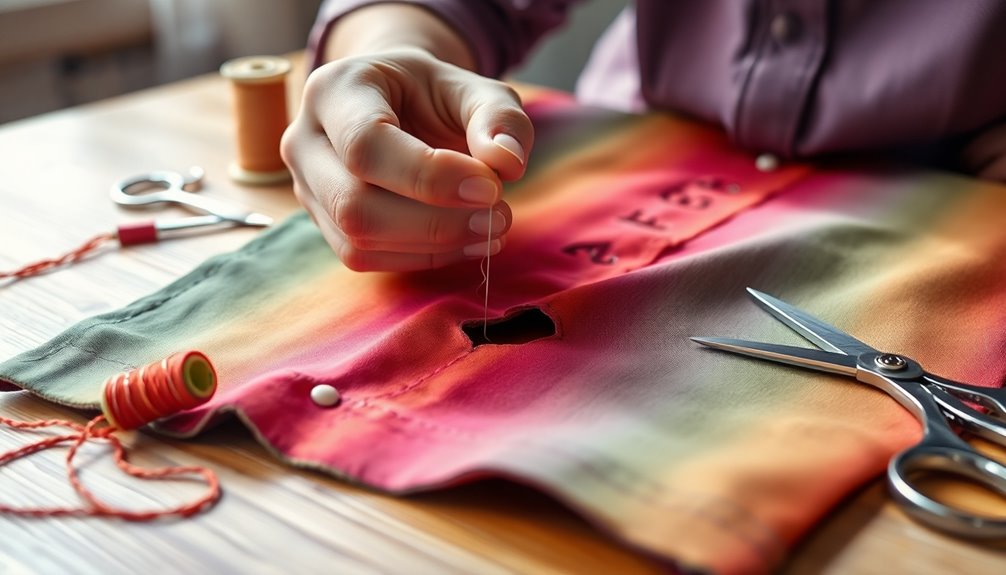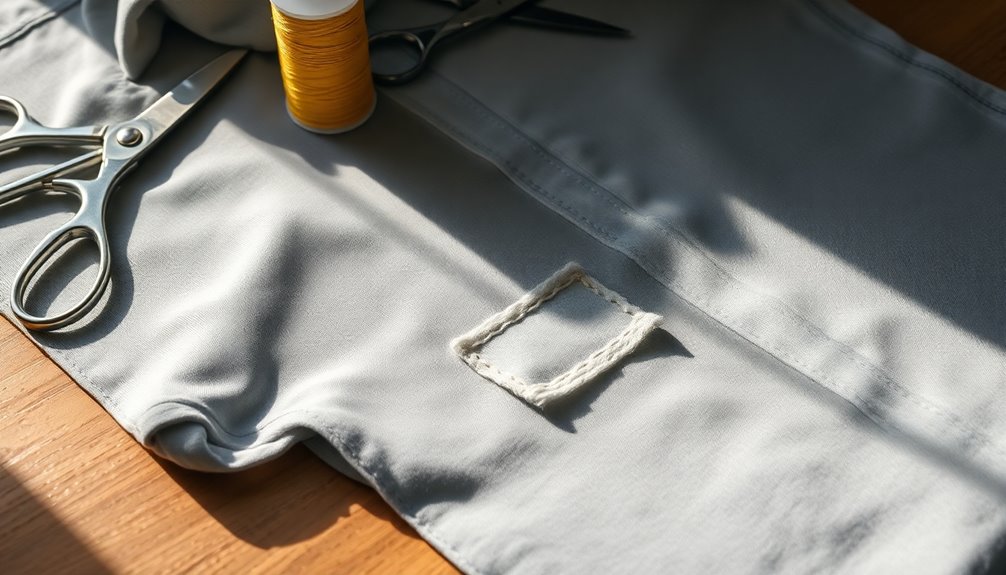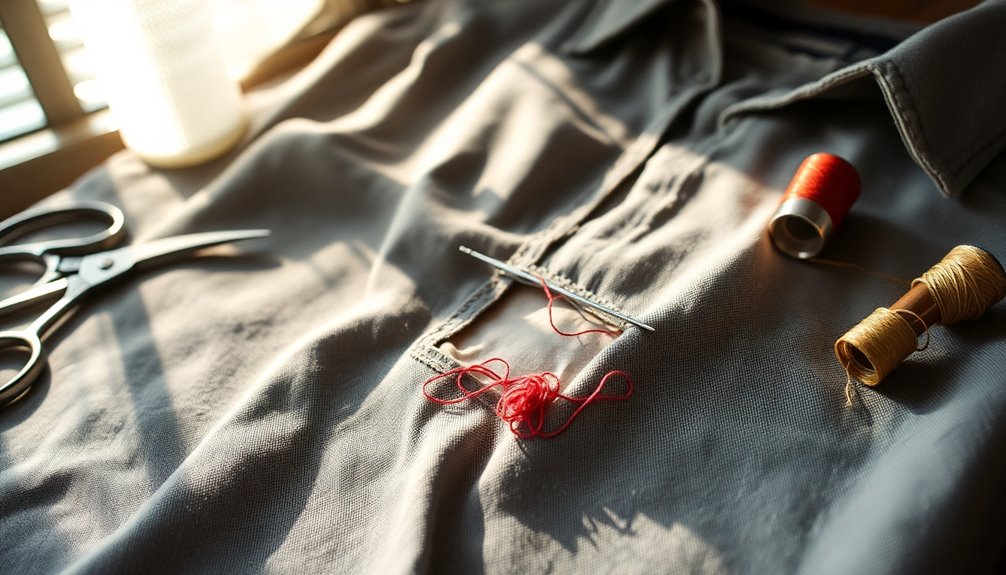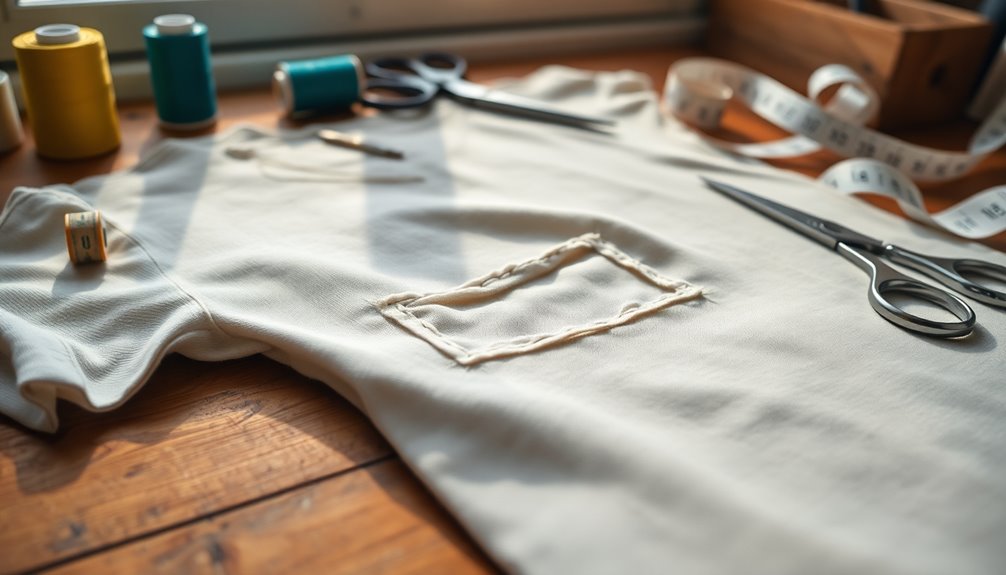You can easily save money by fixing a hole in your shirt instead of buying a new one. Start by gathering a needle, thread that matches your fabric, and sharp scissors. Choose a needle appropriate for your shirt's fabric weight. Use a simple stitch, like the backstitch, to close the hole securely. For larger holes, consider using a fabric patch for extra support. Keep your stitches even to avoid puckering, which makes your repair look neat. Learning these basics not only saves you cash but also contributes to sustainable fashion. There's more to discover to enhance your skills effectively!
Importance of Repairing Clothing
Repairing clothing isn't just a practical choice; it's a smart way to save money and help the environment. When you learn to mend your garments, you can cut down on household expenses considerably—up to 50% of what you'd spend on new items. That's a huge saving!
The average American throws away about 81 pounds of clothing each year, contributing to a massive textile waste problem. By fixing holes and other damages, you can extend the life of your clothes for several more years, promoting sustainable fashion practices. It's a win-win for your wallet and the planet.
Repairing clothes also helps you develop valuable skills that encourage creativity and personal expression in your wardrobe choices. You'll find that the techniques you learn can be commonly used across various clothing items, making it easier to tackle different repairs without hesitation. Additionally, adopting repair techniques contributes to reducing textile waste and supports the move towards a circular economy in fashion.
Moreover, engaging in clothing repair can foster a sense of community. You might share tools, tips, and materials with friends or local groups, creating connections that enrich your experience.
Essential Materials for Sewing
To successfully fix holes in your shirts, you'll need to gather some essential materials.
Start by choosing thread that closely matches the fabric color and selecting the right needle for your fabric type. Additionally, using an app with receipt scanning capabilities can help you track any sewing-related expenses effectively. Budget apps can also provide real-time insights into your overall financial situation, assisting you in managing your sewing budget.
Don't forget to have sharp scissors and a thimble on hand to make the process smoother and safer. Additionally, consider using expense management apps to help track your sewing expenses and save money on materials.
Thread Color Matching
Choosing the right thread color is vital for mending holes in shirts effectively. A well-matched thread guarantees your stitches blend in seamlessly, making them nearly invisible.
Here are some key points to take into account:
- Solid vs. Patterned Fabrics: If your fabric has a pattern, select a solid thread that matches one of the prominent shades. This maintains visual consistency and keeps the focus on the design.
- Texture Considerations: For fabrics with a sheen, like silk or satin, choose a thread that mimics that finish. This helps avoid noticeable differences in texture that could draw attention to the repair.
- Lighting Matters: Always test your thread color against the fabric in natural light to accurately assess the match. Color perception can vary greatly under different lighting conditions, so this step is vital.
Needle Selection Tips
Selecting the right needle is essential for achieving a successful repair on your shirt. To help you navigate the needle types overview, start by choosing a needle that matches your fabric. For lightweight materials like silk or chiffon, opt for a fine needle (size 60-70). If you're working with heavier fabrics like denim, a thicker needle (size 90-100) is necessary. Universal needles (size 80-90) are versatile and great for beginners, as they work well with most woven and knit fabrics.
For delicate fabrics, use a ballpoint needle, which has a rounded tip that prevents snags and damage. If you're sewing multiple layers or thicker materials, a heavy-duty needle will handle the extra thickness without bending or breaking.
Keep in mind the needle size guide when selecting your needle. Always guarantee your needle is sharp and in good condition; dull needles can cause skipped stitches and damage your fabric.
To extend the life of your needles, follow some needle maintenance tips, such as changing them regularly and keeping them clean. With the right needle, you'll be well on your way to effectively repairing your shirt!
Additional Tools Needed
When fixing holes in shirts, having the right tools can make all the difference in achieving a professional-looking repair. Here are some essential materials you'll need to get started:
- Needle and Thread: Choose a needle that suits your fabric type, and match the thread color to your shirt. This guarantees a seamless, invisible repair.
- Scissors: Keep a pair of sharp scissors handy for trimming any excess thread after sewing. A clean finish is key to a polished look.
- Thimble: Use a thimble to protect your fingers, especially when pushing the needle through thicker fabrics or multiple layers.
While you may have basic sewing tools, consider investing in alternative tools and sewing gadgets that can streamline your process.
Don't forget about tool maintenance; keeping your scissors sharp and your needles in good condition will improve your sewing experience overall.
With these essential materials, you'll be well-equipped to tackle any shirt repair and save money in the long run.
Step-by-Step Repair Process

Now that you've gathered your materials, it's time to get into the step-by-step repair process.
You'll learn effective stitching techniques that guarantee a smooth finish and tips for those final touches. Additionally, understanding budget management tools can help you save money in the long run by avoiding unnecessary expenses. Regular reviews of your savings and investments can also provide insights into your overall financial health and help you allocate funds more effectively. By utilizing coupon codes when purchasing sewing supplies, you can further enhance your savings.
Let's make that hole a thing of the past!
Gather Necessary Materials
Before you start repairing holes in your shirt, it's essential to gather the necessary materials. Taking the time to collect everything you need makes the process smoother and helps you avoid interruptions while you work.
Here's what you should have on hand:
- Needle: Choose one that's appropriate for your fabric type. Verify it's sturdy enough for your repair task.
- Thread: Select a color that closely matches your shirt fabric. This will help keep your stitches less visible.
- Scissors: Have a pair ready to trim any excess thread once you've completed sewing.
Additionally, consider having a fabric patch if the hole is larger, as this provides extra support. Keep a thimble handy too; it'll protect your fingers when pushing the needle through thicker fabric or multiple layers.
Organizing your workspace with these gathered materials will set you up for success. Preparing for repairs not only saves you time but also enhances your confidence in tackling the task at hand.
Now that you've got everything ready, you're well on your way to giving your shirt a new lease on life!
Stitching Techniques Explained
With your materials gathered and ready, it's time to tackle the actual stitching process. Start by selecting a thread color that matches your shirt; this helps your stitches blend seamlessly. Choose a needle suitable for the fabric type, as fabric types explained will guide you in making stitching easier and more effective.
If you're using a sewing machine, remember the sewing machine basics, like adjusting the stitch length for a tighter seam. However, if you prefer hand stitching techniques, begin by employing a seam stitch to close the hole. Place your stitches close together for an invisible finish, ensuring the repair is neat.
While stitching, maintain even tension to avoid puckering, which can ruin the appearance on both sides of the fabric. Take your time and don't rush this part; a careful approach leads to a better result.
Once you've closed the hole, secure your stitches with a knot at the end. This prevents unraveling and enhances the longevity of your repair. By following these steps, you'll not only save money but also extend the life of your favorite shirt!
Final Touches and Tips
When it comes to final touches after repairing a hole in your shirt, attention to detail makes all the difference. Completing your repair properly guarantees your garment not only looks good but lasts longer.
Follow this final inspection checklist to wrap up your project:
- Color Match: Choose a thread that closely matches your fabric color. This keeps your repair inconspicuous and enhances the garment's overall appearance.
- Tension Control: Maintain consistent tension while stitching. This prevents puckering and gives a smooth finish, essential for garment longevity strategies.
- Secure Knot: Always finish by tying a secure knot on the inside of the garment. This prevents the thread from unraveling and keeps your repairs intact over time.
Incorporating these repair maintenance tips will help you achieve a professional look.
For larger holes, don't hesitate to use a fabric patch on the inside for added support.
Remember, a little attention to these final touches can extend the life of your favorite shirts, saving you money in the long run.
Happy sewing!
Techniques for Invisible Stitching
Achieving an invisible stitch can transform a damaged shirt into a wearable piece again. To start, select a thread that closely matches your fabric color; this simple step helps blend your repair seamlessly. Additionally, using AI-driven tools can enhance your shopping experience by suggesting high-quality threads that suit your project. Ethical shopping practices can also inspire you to choose sustainable materials for your sewing projects, which can promote sustainability in your crafting.
Next, use a seam stitch technique to close the hole. For the best results, make certain your stitches are small and closely spaced, enhancing the invisibility of your work.
Thread tension is vital during this process. Maintaining even tension keeps the fabric smooth and prevents puckering around the repair area, which can draw unwanted attention.
Remember to adjust your stitch size variations based on the fabric type; finer fabrics may require smaller stitches, while thicker materials can handle larger ones.
Once you've finished stitching, secure your work with a knot to prevent unraveling and guarantee the longevity of your repair.
It's important to practice patience and focus while stitching; the more you practice these invisible stitching techniques, the more discreet your repairs will become over time. Additionally, maintaining timely payments on your sewing supplies can help you stay organized and avoid any financial strain while pursuing your crafting projects.
With these methods, you can confidently give your shirt a new life without breaking the bank.
Tips for Mastering Sewing Skills

To master sewing skills, regular practice is key, and you can start by focusing on basic stitches like the backstitch and seam stitch. These foundational techniques will enhance your muscle memory and precision, helping you tackle various sewing challenges with confidence. Additionally, engaging in live money-management workshops can provide structured learning opportunities that are similar to sewing classes. Developing your financial literacy can also empower you to make informed decisions when investing in quality sewing materials.
Here are three tips to elevate your sewing game:
- Choose the Right Fabric: Different fabrics behave differently. Experiment with various fabric choices to understand how they respond to stitches, which will aid in creative mending. Knowing how to handle diverse materials can make your repairs more effective. Understanding the nuances of different fabrics will help you select the best option for each repair.
- Match Your Thread: Always use a thread color that matches your fabric. This guarantees your repairs blend seamlessly, creating an invisible repair that looks professional. A well-matched thread not only enhances aesthetics but also ensures durability.
- Stock Your Sewing Kit: Keep a well-stocked sewing kit with essentials like needles, scissors, and a thimble. This preparedness will motivate you to tackle mending projects as they arise. Consider adding automated features to your sewing tools, as these can further streamline your mending process and enhance your efficiency. Regularly reviewing your kit and replenishing it with necessary supplies can also prevent delays in your sewing projects.
Engaging with online tutorials and sewing communities can also provide valuable insights and feedback from experienced sewists. Additionally, learning about automated features in sewing tools can further streamline your mending process and enhance your efficiency.
Community and Resources for Learning
Sewing enthusiasts often find that engaging with a community can greatly enhance their learning experience. Online communities, such as forums and social media groups, provide a platform for resource sharing, where you can connect with fellow sewists. Here, you can exchange tips, ask questions, and gain encouragement, which can be invaluable as you tackle new projects. Additionally, many individuals share their experiences with budgeting apps to help manage the costs associated with sewing.
YouTube is another fantastic resource, offering countless video tutorials that visually demonstrate various sewing methods. This makes it easier for you to follow along and learn at your own pace.
If you prefer hands-on learning, consider attending community classes at your local fabric store or adult education center. These workshops often cover basic sewing skills and provide expert guidance.
Additionally, numerous websites and blogs focus on sewing, frequently publishing articles, downloadable patterns, and step-by-step guides to assist you.
Don't forget about your local library, which may offer a wealth of sewing books and magazines, packed with in-depth information on techniques, repairs, and mending skills. Engaging with these resources won't only boost your skill enhancement but also deepen your love for sewing. Moreover, using budgeting apps can help you manage your sewing budget effectively, allowing you to plan for future expenses related to your sewing projects.
Benefits of Sustainable Fashion

Sustainable fashion offers numerous benefits that can positively impact both your wardrobe and the environment. By embracing sustainable practices, you not only make a difference but also enjoy several personal advantages.
- Reduced Environmental Impact: The fashion industry is responsible for about 10% of global carbon emissions. By choosing sustainable materials and supporting brands that prioritize eco-friendly practices, you help reduce this significant footprint.
- Cost Savings: Repairing and reusing garments can save your household between $50 to $100 annually. Instead of buying new clothes, fixing what you already own keeps money in your pocket while minimizing textile waste, which amounts to 92 million tons each year.
- Ethical Labor Practices: Sustainable fashion emphasizes ethical sourcing, ensuring that garment workers receive fair wages and work in safe conditions. By supporting these brands, you contribute to a fairer industry.
Investing in high-quality, sustainable clothing means you're more likely to own longer-lasting garments. This approach not only enhances your wardrobe but also fosters a more responsible fashion industry.
Embracing sustainable fashion is a win-win for you and the planet.
Conclusion
By fixing that hole in your shirt, you're not just saving money; you're embracing a sustainable approach to fashion. Each stitch you make not only repairs your clothing but also builds your skills, turning frustration into creativity. Coincidentally, as you learn and improve, you'll find joy in personalizing your wardrobe. So grab those materials, immerse yourself in the process, and remember: every small repair you make contributes to a bigger change in our world. Happy sewing!



